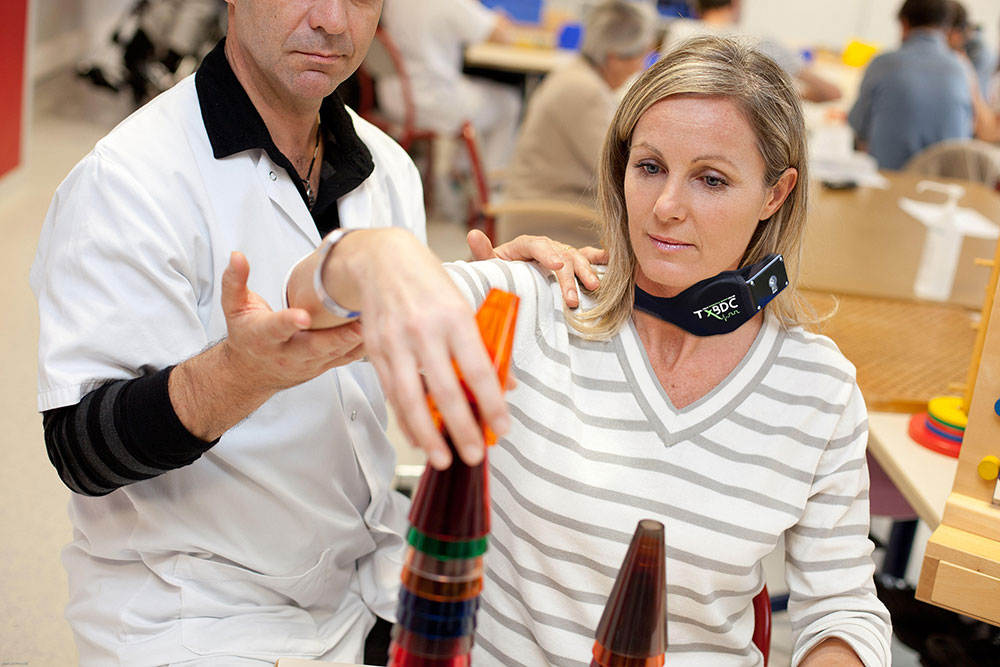Stroke of Genius
by Stephen Fontenot
A stroke-therapy project initiated in a UT Dallas lab a decade ago is now yielding encouraging clinical results.
For the 7 million American survivors of stroke, increasing the effectiveness of physical rehabilitation for mobility and motor skills could provide a transformative boost in quality of life.
Researchers from The University of Texas at Dallas’ Texas Biomedical Device Center (TxBDC) conceived a therapy involving vagus nerve stimulation (VNS) to rewire circuits in the brain more than a decade ago. Scientists have since been refining the technique to treat a variety of disorders, including stroke. In August 2021 the Food and Drug Administration (FDA) approved their rehabilitation system for chronic ischemic stroke survivors, making it the first such treatment of its kind.
The Vivistim Paired VNS System is produced and commercialized by MicroTransponder, a spinoff company started by UT Dallas graduates. The results of a pivotal double-blind, placebo-controlled, randomized clinical trial were published in April 2021 in The Lancet. The study showed that in patients with arm and hand weakness after stroke, pairing VNS with rehabilitation exercises led to improvements that were two to three times greater than the control group receiving rehabilitation alone.

From left: Dr. Michael Kilgard, Dr. Seth Hays and Dr. Robert Rennaker
Dr. Michael Kilgard, the Margaret Fonde Jonsson Professor of neuroscience in the School of Behavioral and Brain Sciences (BBS) and interim executive director of the TxBDC and its chief science officer, described FDA approval of the system as “the most significant success” in the center’s 10-year history.
“This announcement means that stroke survivors all over the country can soon begin receiving a safe and effective therapy to improve their recovery,” he said.
The FDA also gave Vivistim a Breakthrough Device Designation, which is reserved for technology that treats life-threatening or irreversibly debilitating conditions and has significant advantages over any existing alternatives.
How It Works
The vagus nerve travels up the neck from the chest and abdomen and relays information between the brain and the body. The nerve regulates processes like digestion, heart rate and respiratory rate. In VNS, an implanted device stimulates the nerve with electrical impulses. Similar devices are currently FDA-approved to treat epilepsy and depression.
Researchers affiliated with the TxBDC, BBS and the Erik Jonsson School of Engineering and Computer Science developed the technique of targeted plasticity therapy, now called paired VNS, which combines limb movements with electrical stimulation delivered to the vagus nerve via an implanted device in the neck.
“The idea is that we can’t fix the region of the brain that’s been damaged by stroke, but we can help the remainder of the brain rewire to get the job done,” Kilgard said. “This recovery doesn’t happen spontaneously.”
Kilgard explained that, for the two-thirds of stroke survivors who are chronically disabled, the potential for recovery via physical therapy after a stroke is usually limited to the first six months.
“In that initial period after a stroke, people can regain some use of their upper limbs, but usually there’s not much recovery after that. Most people plateau even if they keep working at it,” he said. “But the first studies of our technique in humans showed that by adding VNS, patients can recover to a degree that they would not otherwise — even if they start 10 years after their stroke.”
‘Grassroots’ Research Leads to Patient Therapy
The initial work with VNS at UT Dallas began with Kilgard and Dr. Robert Rennaker, associate director and chief technology officer for the TxBDC, the Texas Instruments Distinguished Chair in Bioengineering and a professor of neuroscience in BBS. Their research was initially aimed at treating tinnitus — the perception of sound, like a ringing in the ears, with no external source.
“This long road began with a paper in Nature in 2011 about treating tinnitus,” Kilgard said. “The founders of MicroTransponder stayed in Dallas to commercialize paired VNS therapy for both stroke and tinnitus.”
Navzer Engineer PhD’04, chief scientific officer at MicroTransponder, worked with Kilgard on the initial preclinical VNS studies, which were supported at the time with a $1.7 million grant from the National Institutes of Health.
“Our stroke study published in The Lancet was the culmination of a large amount of preclinical research that we started over a decade ago at UT Dallas,” Engineer said. “This would not have been possible without a dedicated team of amazing students and researchers at UTD.”
Dr. Seth Hays, associate professor of bioengineering, started working on the project as a postdoctoral student in spring 2012, joining then-doctoral candidate Navid Khodaparast BS’06, MS’09, PhD’13 and Ben Porter MS’11, PhD’11.
Hays described targeted plasticity therapy and VNS for stroke as “the definition of grassroots” — the approach was invented and developed at UT Dallas, by UT Dallas students, staff and faculty.
“We’ve taken the opportunity to develop this here, and a lot of people in Texas should be proud of it — the individuals who enrolled in the study, the team at MicroTransponder, the medical centers that were involved and the University,” Hays said.
Kilgard said 22 TxBDC-affiliated researchers have been authors of the journal articles that reported early preclinical and clinical results for the stroke therapy, supported in the scientific process by more than 200 TxBDC students and staff.
“From its inception, the Texas Biomedical Device Center has worked as a team with a singular focus of providing patients with new hope for greater recovery,” Rennaker said. “All of the preclinical and much of the clinical research that led VNS for stroke from an invention to an approved therapy was conducted right here.”
The TxBDC at UT Dallas was established in 2012 with donations from Texas Instruments, a private donor and matching funds from the UT System Regents’ Research Incentive Program. Since then, it has generated more than $35 million in additional funding to develop technologies to prevent injuries and disease.




